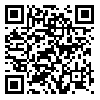Volume 8, Issue 4 (2019)
JCP 2019, 8(4): 441-448 |
Back to browse issues page
Download citation:
BibTeX | RIS | EndNote | Medlars | ProCite | Reference Manager | RefWorks
Send citation to:



BibTeX | RIS | EndNote | Medlars | ProCite | Reference Manager | RefWorks
Send citation to:
Mahbobinejhad Z, Aminian H, Ebrahimi L, Vahdati K. Reduction of aflatoxin production by exposing Aspergillus flavus to CO2. JCP 2019; 8 (4) :441-448
URL: http://jcp.modares.ac.ir/article-3-32452-en.html
URL: http://jcp.modares.ac.ir/article-3-32452-en.html
1- Department of Entomology and Plant Pathology, College of Aburaihan, University of Tehran, Tehran, Iran.
2- Department of Horticulture, College of Aburaihan, University of Tehran, Tehran, Iran. , kvahdati@ut.ac.ir
2- Department of Horticulture, College of Aburaihan, University of Tehran, Tehran, Iran. , kvahdati@ut.ac.ir
Abstract: (3437 Views)
Aspergillus flavus is a saprophytic fungus contaminating different food and nut products by aflatoxin which is a major problem worldwide. Modified atmosphere packaging (MAP) could be an effective method for control of saprophytic fungi and their toxins and secondary metabolites production. This study gives the consequences of fungal isolates growing under MAP condition on potato dextrose agar (PDA). Two isolates of A. flavus (A42 and CHAO50) were packed under 100% CO2, 100% O2 and vacuum conditions. The mycelial growth of fungal isolates on PDA was controlled up to 80% with CO2 treatment. Under the vacuum condition, mycelial growth of the isolates was inhibited up to 30%, while 100% oxygen had no inhibition on mycelial growth. Examination of isolates A42 and CHAO50 under UV light showed that both isolates produced yellow pigments on aflatoxin producing ability (APA) medium after 10 days. The levels of aflatoxin B1, B2, G1, G2 and total aflatoxin were analyzed chromatographically. The results revealed that the highest concentration of total aflatoxin was produced by fungal isolates grown in an atmosphere of 100% O2, while the level of aflatoxins was significantly reduced in 100% CO2.
Article Type: Original Research |
Subject:
Plant Disease Management
Received: 2019/04/29 | Accepted: 2019/09/16 | Published: 2019/10/16
Received: 2019/04/29 | Accepted: 2019/09/16 | Published: 2019/10/16
Send email to the article author
| Rights and permissions | |
 |
This work is licensed under a Creative Commons Attribution-NonCommercial 4.0 International License. |








